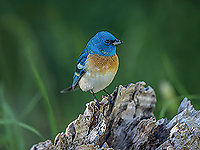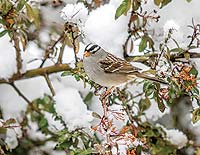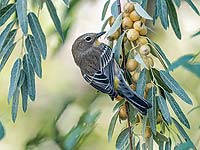 |
| Lazuli Buntings can be seen and heard around Moab during the warmer months. Photo by Nick Eason. |
As life slowed last spring, I decided to try improving my bird identification skills, and try training my brain to recognize more bird songs and calls. The tools for improving birding skills have exploded over recent years. Birding apps including Merlin and iBird provide field-friendly keys and guides, and include audio of bird calls and songs. With a few birding skills, you can contribute your observations to science that supports bird conservation through other apps, especially eBird or iNaturalist.
The Moab Bird Club coordinates field trips, potlucks (pre-Covid), and their biggest annual event, the Moab Christmas Bird Count (CBC). Begun by the Audubon Society in 1900, the CBC is the longest running citizen science program in the world. Local organizers each designate a 15-mile diameter count circle. The Moab circle, created in 1984, includes the Moab Valley, Castle Valley, and the connecting Colorado River corridor. On a chosen late December day, small groups of birders scour assigned areas within the circle. They search along trails, streets and canyons, spotting our common Mallards, Northern Flickers, White-crowned Sparrows, and others. They delight in sighting a Bald Eagle along the river, a secretive Marsh Wren in the wetlands, an uncommon Merlin, or a Spotted Sandpiper that didn’t travel as far south as usual. Then they compare notes, and coordinator Marcy Hafner compiles the data to submit to Audubon.
 |
| The Moab Christmas Bird Count tallied 355 White-crowned Sparrows in December 2019. Photo by Nick Eason. |
Besides the fun aspects, this CBC data is important to understanding what’s happening to birds. A 2019 study determined that three billion birds have disappeared worldwide since 1970, a 29 percent decrease in under 50 years! The numbers are based on analysis of historical data from the CBC, the North American Breeding Bird Survey (initiated in 1966), and innumerable smaller or regional surveys. Recent data came from these same, ongoing surveys, and from a wealth of data submitted by individuals, especially through eBird.
Managed by the Cornell Lab of Ornithology since 2002, eBird has seen huge recent growth in popularity. Some data is presented on the eBird website as range and abundance maps, and fascinating animated maps of how individual bird species move through the year. The animated maps are for long-distance migrators including Western Kingbirds and Common Nighthawks, altitudinal migrators including Mountain Chickadees, and birds that use both strategies or never migrate in some parts of their ranges, including House Finches and Common Ravens. Cornell Lab and other researchers analyze the data for effects of various climate change factors, how this fall’s migration was affected by 2020’s extensive western wildfires, population trends within various habitats, and much more.
 |
| Most warblers migrate farther South in the Fall, but Yellow-rumped Warblers can be seen in the Moab Valley all year. Photo by Nick Eason. |
It feels rewarding to contribute to data that can lead to better bird conservation. Further, the time outdoors and the focus on what type of beak that songbird has, where the white patches on that duck are, or which of our two chickadee species has a higher pitched song, is a welcome respite from the stresses of life, Covid, and the world news.
Contact Marian Eason at nmeason@preciscom.net to be added to Moab Bird Club emails.
|